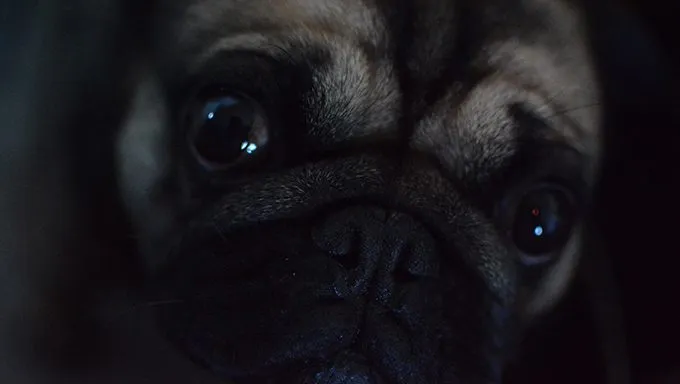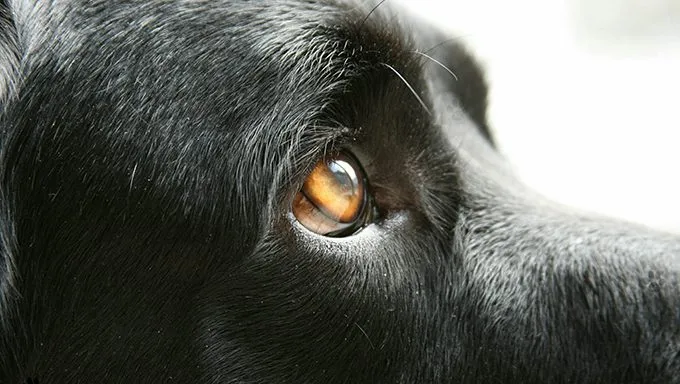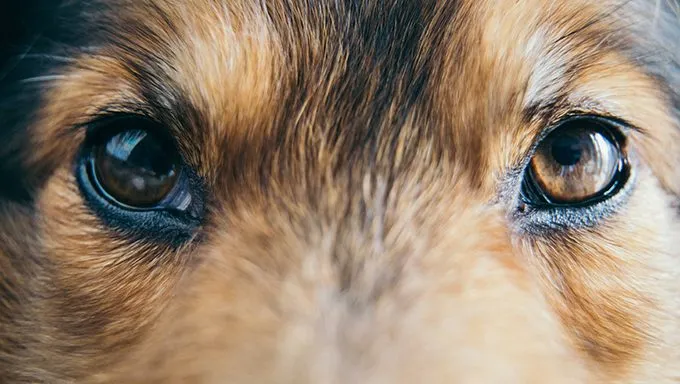In many ways, dogs and people see the world differently. Many people wonder if dogs can see color or if dogs can see in the dark as well as humans do.
You may have heard that dogs are completely colorblind or other rumors about the way their vision works.
The reality of how dogs see may actually surprise you.
Can Dogs See Color?
Many people believe that dogs are colorblind or that dogs cannot see color.
Yes, early research indicated that dogs were unable to perceive color. But the popular idea that dogs see in black and white is nothing but a perpetuated myth. Dogs can see color, it’s just that the color range they perceive is limited compared to humans.
There are two types of photoreceptors in the retinas of both humans and dogs, called rods and cones. The cones are responsible for color perception.
The human eye contains three types of cones, allowing us to see a broad spectrum of color. Dogs’ eyes have two types of cones, so their ability to perceive color is limited compared to humans.
To put it in very basic terms, the canine color field consists mostly of yellows, blues, and violets. “Human” reds, greens, and oranges are not distinguishable to dogs and appear somewhere on their yellow to blue spectrum.
Can Dogs See In The Dark?

Cats are often thought of as the pets who see best in the dark. While that’s true, dogs’ ability to see in the dark isn’t too far off from cats.
Dogs’ eyes have many adaptations to make them able to see quite well in the dark. For example, dogs have larger pupils, which allow more light to pass through the eyes.
And while dogs may have fewer cones in their eyes than humans, they have more light-sensitive cells, called rods. The rods in dogs’ eyes work better in dimmer light than the cones that detect color.
The lens of dogs’ eyes is also closer to the retina than ours, which makes the image on the retina brighter, even in dimmer situations.
Dogs have an advantage to seeing in the dark because of a part of the eye called the tapetum. This part of the eye is like a mirror in the back of the eye that reflects light, giving the retina another chance to register the light — and therefore the image — that has entered the eye.
It is the tapetum that gives dogs’ and cats’ eyes that eerie “glowing” look in the night; it’s literally reflecting the light from the dog’s surroundings.
It’s estimated that dogs can see five times better in the dark than us humans.
Do Different Dog Breeds See Differently?

Researchers agree that all dog breeds roughly perceive the same spectrum of colors and have similar abilities to see in dark settings. However, anatomical differences, such as a longer snout or the position of the eyes, can cause a slight difference in how different dog breeds are able to see color and in the dark.
For example, if a dog has eyes that are very close together and has a shorter snout, the overlap of the field of vision of the two eyes may be larger than, say, a dog with eyes that are farther apart and a long snout.
This is known as binocular vision, and a larger overlap — if the eyes are closer together — would make for a keener sense of depth perception.
Is Dog Vision Different From Human Vision?

Dogs have another edge over human vision besides their ability to see better in the dark.
Humans have a fovea in each eye, which is a small indentation in the retina of the eye that allows us to take in vivid detail. Dogs do not have fovea in their retinas, so while they may not be able to see details as well as we can, this allows dogs’ eyes to be much better at tracking motion.
Do you ever wonder how your dog always sees that squirrel dart up a tree from 50 feet away? It’s because a lack of fovea allows the eye to concentrate on motion and movement.
In terms of 20/20 vision, dogs have 20/75 vision. This means that a visual detail that a dog can barely make out from 20 feet is a visual detail a human with 20/20 vision could easily see from 75 feet away.
This doesn’t mean that your dog is blind; it just means that your dog sees details in a softer, blurrier focus than you do.
Yes, you and your dog see the world differently. If you have been wondering if dogs can see color or if dogs can see in the dark, the simple answer is yes. Humans are able to see more colors and detect visual details better than dogs, but dogs can see in the dark even better than humans and are able to detect motion much better than humans.
Do you notice that your dog sees better than you in the dark? Have you ever wondered about your dog’s vision? Let us know in the comments below!
Related Articles:









